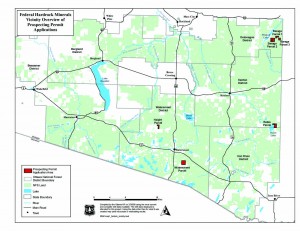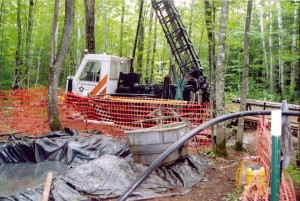By Gabriel Caplett
March 20, 2009
Marquette, Michigan – Current pollution from past chemical, mining and military operations were addressed alongside the potential for continued public health threats posed by coal power generation and mining activities, Thursday, at the Women’s Federated Clubhouse, in Marquette. The event, organized by the Great Lakes Health and Environment Action League (HEAL), featured presentations by area health professionals, toxicologists and university professors.
Event moderator, Gene Champagne, said the event was significant for many because public health concerns are “universal.”
“No one wants to be ill,” said Champagne. “We’re talking about the health, our own health, our parents, our children. That matters to everyone.”
Heavy Metals a Concern in Water and Air
Dr. Lisa Long, a family practitioner in Negaunee, discussed various heavy metals and their potential to affect human health. According to Long, metals such as arsenic, lead, chromium, thallium and cadmium are commonly associated with mine-related pollution. Cadmium, which is also contained in sewage sludge fertilizers, as well as medical and household incinerated waste, is also commonly found in cigarettes.
“If you smoke, you’ve got twice the exposure as somebody who doesn’t,” said Long.
Although highly toxic, particularly to children and pregnant women, lead is also fairly common in everyday life. “The only metal with more commercial uses is iron,” said Long.
According to Long, lead has a “sweet” taste and was commonly used by ancient Romans to sweeten cheap wine. It is that sweetness that makes the metal attractive to young children exposed to the metal. Children absorb roughly fifty percent of lead they ingest, compared to only ten to fifteen percent for adults. The absorption rate is higher with airborne exposure to lead.
Dr. Alan Olson said that, for metals like lead, “zero tolerance should be the rule.”

Dr. Scott Emerson explaining how much lead the human body requires
Shawn Devlin, of Chocolay Township, disagreed. “When you argue for zero you lose credibility,” Devlin said. “There are natural levels of all these things.”
Dr. Scott Emerson, a toxicologist and emergency room physician at Marquette General Hospital, responded that lead has no positive function in the human body and is only found in unsafe amounts as a result of industrial activities.
“There is no safe level for lead, period,” Emerson said.
Emerson also discussed the role of mercury in affecting public health near mining operations. According to Emerson, high sulfate levels in water can assist in increasing concentrations of methyl mercury, a potential problem at Kennecott Mineral’s proposed Eagle Project mine and Humboldt milling facility, both in Marquette County.
Emerson describes methylated mercury as “the most dangerous neurotoxic form of mercury. You get a very aggressive toxin that can go right into the brain and is very readily absorbed.”
According to Dr. Gail Griffith, professor emeritus of Northern Michigan University’s (NMU) chemistry department, coal-fired power plants are another source of mercury, which bio-accumulates in fish tissue and can cause serious human health problems, particularly in young children.
Orthopedic surgeon, Dr. Clayton Peimer cautioned that exposure to “micro-particulates” can be hazardous even if the substance does not contain toxic elements like lead.
“If someone says to you “micro-particles,” go get a mask,” warned Peimer.
Dr. Emerson agreed, maintaining that air pollution “is much more dangerous and has much more impact on health than even the water pollution does”
This surprised Negaunee resident Laura Royea.
“The environmental concerns, the airborne pollutants were very important, the particulate matter,” said Royea. “I had not considered that. I always thought of runoff into the streams and, you know, I didn’t think of the things that become airborne and travel much farther.”

Audience Members at Your Water Your Health
Public Health Threats in the UP
Dr. Griffith discussed ongoing contamination at a number of sites throughout the Upper Peninsula, including the former Cliffs-Dow site that produced charcoal and wood distillate chemicals in the City of Marquette. The company’s dumps closed in the 1960s and eventually became federally-listed Superfund sites.
“You could always tell when they were cleaning out the stills because you could smell it,” said Griffith
For over fifty years, Cleveland Cliffs International (now Cliffs Natural Resources) released mercury from it’s Ishpeming laboratories into the city’s wastewater. That mercury found its way to Deer Lake.
“Some fish of some types from some bodies of water you should never ever eat and that is Deer Lake, for example,” said Griffith.
Griffith explained current public health threats posed by other sites, such as Torch Lake, near Houghton, and the former K.I. Sawyer Air Force Base, northeast of Gwinn. Although the air force complex was closed in the early 1990s, underground storage tanks, landfills, munitions testing areas and fuel spills continue to threaten groundwater quality.
“As we speak there is still a plume of jet fuel headed for Silver Lead Creek,” Griffith said.
Griffith also discussed problems associated with radioactive materials. Republic is considered a “hotspot” for radon, the second major cause of lung cancer, after smoking. In the 1990s, a survey of Republic homes showed that eighty-four percent exceeded maximum exposure levels for the dangerous gas.
A different radioactive element, uranium, has been found in residential wells along the Keweenaw Peninsula, prompting exploration companies to explore for the substance near Lake Gogebic.
“So far they’ve found a little sniff of it but not very much,” said Griffith.
According to NMU sociology professor, Dr. Patricia Cianciolo, new uranium and metallic mining proposals have received some support due to the potential for increased job creation.
“People leave this area when they are young because there is a lack of jobs,” said Cianciolo.
Cianciolo said the lack of regional mine employment pales when compared to the potential threat to residential wells and aquifers from metallic sulfide and uranium mining projects in the western UP.
“It’s just profound to see how close the potential mine sites would be to our major water supplies,” said Cianciolo.
Flambeau Mine Still Polluting
Mining was also a strong theme in Dr. Emerson’s presentation. Emerson explained that Kennecott Mineral’s closed Flambeau copper mine, in Wisconsin, polluted the nearby Flambeau River and continues to discharge high levels of unregulated heavy metals.
“The best predictor of future behavior is past behavior,” Emerson explained. “Kennecott, in general, has not left a good footprint when they have had past mining.”
Emerson said that high levels of manganese have been of particular concern at the Flambeau site. Chronic exposure “basically causes a schizophrenic type psychotic illness which can progress to motor abnormalities and Parkinson’s-type disease,” Emerson said.
“Although they did test the Flambeau River all the testing was done above where the most contaminated stream was in confluence with the Flambeau River,” said Emerson.
“There seems to be some real regulatory failure on the part of the State of Wisconsin on this.”
Marquette resident Brenda Hershey said that the information on Flambeau made her “more concerned.”
“When the research showed they were above levels they just stopped the research,” said Hershey. “How can we base decisions about Marquette [County] on information that is not complete?”
According to Emerson, despite high levels of “indicator” metals, such as copper and zinc, studies for lead and other heavy metal contamination at the Flambeau mine site were not presented to the public. Studies conducted by Colorado-based Stratus Consulting showed that, based on Flambeau results, Kennecott’s proposed Eagle mine could have lead levels nine times what is allowed in the mining permit issued by the Michigan Department of Environmental Quality as well as high levels of cadmium, which can cause kidney damage.
“This is at best regulatory incompetence and, at worst, highly unethical shenanigans on the part of the DEQ,” said Emerson.
According to HEAL’s website, the group “is an information warehouse focused on water and air quality and related environmental health topics in the Great Lakes Basin” and sees it’s role as a facilitator of “user-friendly” information between the citizens and science and health professionals.



